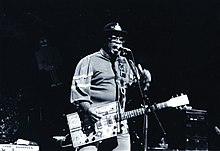


The Bo Diddley beat is a syncopated musical rhythm that is widely used in rock and roll and pop music.[1][2][3] The beat is named after rhythm and blues musician Bo Diddley, who introduced and popularized the beat with his self-titled debut single, "Bo Diddley", in 1955. The beat is essentially the Afro-Cuban clave rhythm[4] or based on the clave[5][6] or a variation thereof.[7][8]
Music educator and author Michael Campbell explains that it "shows the relationship between Afro-Cuban music, Americanized Latin rhythms, and rock rhythm ... [The beats] are more active and complicated than a simple rock rhythm, but less complex than a real Afro-Cuban rhythm.[8]

The Bo Diddley beat is a variation of the 3-2 clave, one of the most common bell patterns found in Afro-Cuban music that has been traced to sub-Saharan African music traditions.[10] It is also akin to the rhythmic pattern known as "shave and a haircut, two bits", that has been linked to Yoruba drumming from West Africa.[11] A folk tradition called "hambone", a style used by street performers who play out the beat by slapping and patting their arms, legs, chest, and cheeks while chanting rhymes has also been suggested.[12]
According to musician and author Ned Sublette, "In the context of the time, and especially those maracas [heard on the record], 'Bo Diddley' has to be understood as a Latin-tinged record. A rejected cut recorded at the same session was titled only 'Rhumba' on the track sheets."[13] Bo Diddley employed maracas, a percussion instrument used in Caribbean and Latin music, as a basic component of the sound.[11] Jerome Green was the maraca player on Diddley's early records, initially using the instrument as a more portable alternative to a drum set.[14] When asked how he began to use this rhythm, Bo Diddley gave many different accounts. In a 2005 interview with Rolling Stone magazine, he said that he came up with the beat after listening to gospel music in church when he was twelve years old.[14]
Prior to Bo Diddley's self-titled song, the rhythm occurred in 13 rhythm and blues songs recorded between 1944 and 1955, including two by Johnny Otis from 1948.[15] In 1944, "Rum and Coca Cola", containing the beat, was recorded by the Andrews Sisters[9] and in 1952, a song with similar syncopation, "Hambone", was recorded by Red Saunders' Orchestra with the Hambone Kids.
Later, the beat was included in many songs composed by artists other than Bo Diddley:
The heart of this [Bo Diddley beat] trademark groove is essentially a 3-2 clave rhythm, played with a strong swing.
Bo Diddley's 1955 self-titled track featuring the 'Bo Diddley Beat' that was based on the clave rhythm.
the Bo Diddley beat, based on the rumba or clave rhythm
The Bo Diddley Beat – This is a variation of the clave made famous by Bo Diddley.